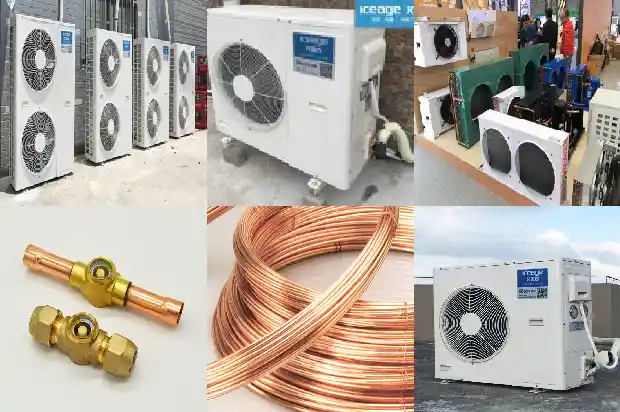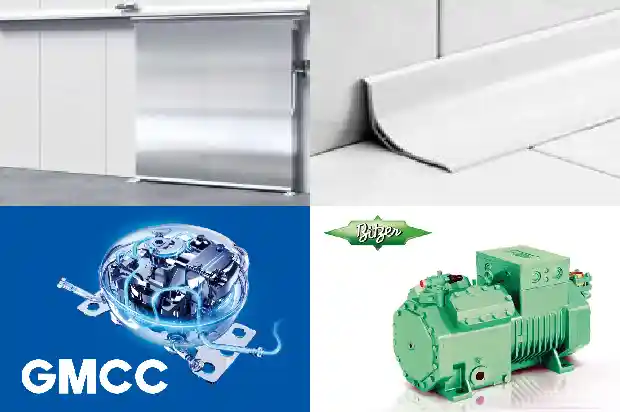Maintenance Methods for Faults in Screw Refrigeration Air - conditioner Compressors
2024-12-29
I. Disassembly
Before the screw compressor undergoes a major overhaul, if possible, unload the slide valve to the "0" position, shut down the compressor normally, and cut off the power supply. Disconnect the pipelines connected to the compressor. After discharging the refrigerant and lubricating oil in the compressor, the compressor can be disassembled. Pay attention to developing good habits during disassembly. Parts from different positions should be placed separately, and necessary assembly marks should be made.
- After removing the pipelines, couplings, and anchor bolts connected to the compressor, lift and transport the compressor to the workplace. It is best to have an operating platform.
- Remove the suction filter and suction check valve.
- Remove the energy indicator.
- Remove the positioning pins, and then remove the suction end cover in parallel. Take out the oil piston and balance piston. Note that when removing the positioning pins, they should only be pulled out, not knocked out. Be sure to remove the positioning pins first, and then remove all the bolts to prevent the weight of the suction end cover from acting entirely on the positioning pins and bending them.
- Remove the shaft seal cover and take out the shaft seal. Be careful not to damage the moving and static rings.
- Remove the positioning pins and then remove the exhaust end cover.
- Remove the bearing gland, lock nut, washer, thrust bearing, adjusting shim, etc.

Use the special tool provided with the machine to remove the lock nut and first open the locking tab of the lock washer. Make marks at any time and place the parts separately.
- After removing the positioning pins, remove the exhaust end seat.
- Use the special eyebolt to slowly and smoothly take out the active rotor, being careful not to collide with the body. At this time, the passive rotor will rotate accordingly.
- Take out the passive rotor.
- Take out the slide valve.
II. Inspection Items
- Check whether there are abnormal wear marks on the inner surface of the body and the surface of the slide valve, and measure the inner surface dimensions and roundness with an inside micrometer.
- Check whether there are wear marks on the end faces of the active and passive rotors and the suction and exhaust end seats.
- Check the wear conditions of the outer diameters and tooth surfaces of the active and passive rotors, and measure the outer diameters of the rotors with an outside micrometer.
- Measure the diameter of the rotor main shaft and the inner diameter of the main bearing hole, and check the wear condition of the main bearing.
- Check the wear condition of the shaft seal.
- Check the deformation and damage of all "O"-rings and springs.
- Check all the internal oil passages of the compressor.
- Check whether the energy indicator is damaged or jammed.
- Check whether the oil piston and balance piston have abnormal wear.
- Check whether the transmission core or diaphragm of the coupling is damaged.
III. Repair Methods
After inspection, damaged parts need to be repaired or replaced. The specific details are as follows:
- For minor wear and scoring, a fitter can polish them smooth with an oilstone. There should be no rust, cracks, or other defects on the surface of the rotor journal and the moving and static rings of the shaft seal. After the surface of the main journal is polished, carefully measure its size, and adjust the main bearing based on this.
- If the main bearing is severely worn and exceeds the clearance limit for shaft fit, it should be replaced. If the method of casting bearing alloy is used, the coaxiality of the inner surface and the bearing hole must be ensured.
- If the thrust bearing is damaged or the clearance increases, a new one must be replaced. And the size of its vacuum clearance should be measured, and the bearing adjusting shim should be selected based on this.
- All gaskets and "O"-rings must be replaced if they are damaged. Gaskets can be made by oneself, but pay attention that there should be no breakage or cracks near the bolt holes to avoid leakage. High - quality materials should be selected for gaskets. The "O"-rings should be made of materials suitable for the refrigerant.
- Clean the sealant on the two end faces of the body and the flat surfaces of the suction and exhaust end seats. Be careful not to scratch the surfaces.
IV. Assembly
After checking each part and repairing or replacing the damaged parts, the assembly work can be carried out. Pay attention to the marks noted during disassembly to avoid confusing the parts. During assembly, measure the assembly clearances of all parts at any time. For parts with excessive clearances, adjust the clearances or replace the parts.
- Clean all parts thoroughly and blow them dry with compressed air.
- Prepare all the required tools and clean them.
- Install the main bearing into the bearing hole in its original position and measure the inner diameter of the bearing to ensure that the inner diameter meets the clearance requirements for the fit with the rotor journal.
- Evenly apply sealant on the joint surface between the suction end seat and the body.
- Lean the suction end seat against the suction end of the body, insert some bolts to bear the weight. After pressing in the positioning pins, tighten the bolts.
- Install the slide valve and its guide bracket. The guide bracket should be positioned with positioning pins first and then fixed with bolts.
- Clean and smear the inner hole of the main bearing at the suction end and the inner hole of the body with the same type of lubricating oil used during operation, and then install the male rotor and the female rotor. The rotor installed later should be slowly rotated in and should not be forced into the body.
- Lean the male and female rotors tightly against the suction end seat, and measure the dimensional difference between the exhaust end face of the rotor and the exhaust end face of the body. This value is the sum of the suction and exhaust clearances.
- Evenly apply sealant on the joint surface between the exhaust end seat and the body.
- Lean the exhaust end seat against the discharge end of the body. After pressing in the positioning pins, tighten the bolts. When installing the exhaust end seat, pay attention to the inner hole of the main bearing to avoid damaging the main bearing.
- Install the adjusting shim and thrust bearing, and use the round nut and lock washer to fix the inner spacer of the thrust bearing on the journal of the rotor. The thrust bearings are installed in pairs, and pay attention to the installation direction.
- Install the rotor bearing gland and press the outer spacer of the thrust bearing tightly against the body. Remove the connecting bolts between the exhaust end seat and the body, and pull out the exhaust end seat together with the rotor. Measure the clearance between the exhaust end face of the rotor and the exhaust end seat. This clearance is the exhaust end clearance. If the clearance is not reasonable, change the thickness of the adjusting shim. After adjusting the exhaust end clearance, assemble. After installation, turn the active rotor according to the actual operating direction. The rotation should be flexible without jamming.
- Install the exhaust end cover with positioning pins, add gaskets and fix it with bolts.
- Install the moving ring of the shaft seal, and smear refrigeration oil on the surface of the moving ring and the rubber ring.
- Install the static ring into the shaft seal gland, add gaskets and fix it on the exhaust end seat with bolts. Adjust the pre - tightening force of the shaft seal spring by changing the thickness of the gasket. Also smear refrigeration oil on the surface of the static ring and the static ring rubber ring.
- Install the oil piston and balance piston. Smear refrigeration oil during assembly.
- Install the suction end seat with positioning pins, add gaskets and fix it with bolts.
- Install the energy indicator, paying attention that the pointer corresponds to the position of the slide valve.
- Install the repaired suction filter and check valve on the suction end seat. Transport the assembled compressor to the unit. After finding the coaxiality, fix the compressor and the motor, and connect them with a coupling.
V. Test Run after Overhaul
After overhaul, conduct an airtightness test and a vacuum test on the compressor. The test run can be carried out only after the tests are qualified. Mainly check whether the operation of the slide valve, the oil pressure of the oil pump, the noise and vibration during operation are normal. The turning of the compressor by hand after shutdown should also be normal.
Related Articles
- Basic Faults and Preventive Maintenance of Water - cooled Units
- Essential for Maintenance! Parameters and Phenomena of Normal Operation of Refrigeration and Heating Systems
- Welding Equipment Used in Refrigeration System Maintenance
- Maintenance Methods for Small Modular Cold Storage Failures
- Maintenance Techniques for Air - conditioning Refrigeration Systems
- Maintenance Strategies for the Working Cycle and Electrical Automatic Control of Chillers
- Essential Basics for Maintenance, Debugging of Refrigeration and Air - conditioning Systems
- 8 Maintenance Procedures for Industrial Chillers
- Requirements and Maintenance for Building Meat Food Cold Storage
- Maintenance Methods for Refrigerant Leak in Air - conditioner Outdoor Unit
- Knowledge, Installation and Maintenance of Cold Storage Systems
- Are you familiar with the detection and maintenance methods of air conditioner components?
- Maintenance and Operation of Freezing and Cold Storage Warehouses
- Water-cooled Screw Chiller: Operation and Maintenance
- Daily Maintenance Training for Users after Installation of Small and Medium-Sized Cold Storages
- Maintenance of Screw Chiller
- Maintenance of Screw Chiller
- On the maintenance and inspection of external insulation layers of pipes in refrigeration devices
